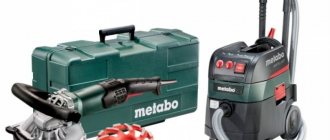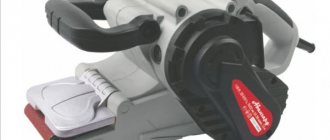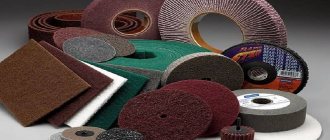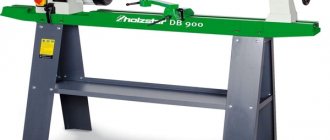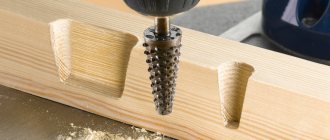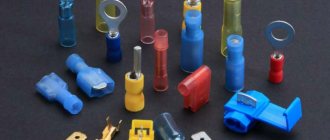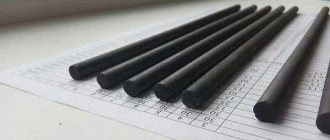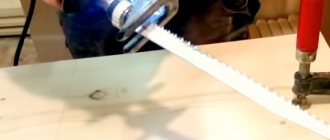0
10258
31.03.2014
A wood sander is an indispensable tool when performing finishing work in a country house. Using a sanding machine allows you to speed up the process of sanding and polishing wooden surfaces - wall cladding, floors, furniture, decorative elements. Wood sanders are convenient and compact, allowing you to perform high-quality leveling of any wooden surface.
Wood sander
There are several main types of sanders for household use; their different designs and operating principles determine their purpose. For construction and repair, carpentry and carpentry work, the following types of grinding machines are used:
- Belt sanders (LSM) are tools for aggressive and rough processing of wooden, plastic, and metal surfaces.
- Vibratory grinders (VSM) allow for softer processing due to circular movements with small amplitude. The grinding surface of the orbital sander has a rectangular shape, which makes it easier to process corners.
- A type of flat vibratory sander is a delta sander; it is distinguished by a triangular shape of the sole. The delta sander is convenient for processing small and hard-to-reach areas, corners, recesses and recesses.
- An eccentric sander refers to a tool that allows you to grind a surface to a polished state due to a combination of rotational and oscillatory movements of the sanding pad. But an eccentric sander is not suitable for processing small surfaces and internal corners.
Types of grinding machines
Purpose and scope
Despite such a wide variety, they all perform almost the same functions:
- preparing the surface for further processing (removing old paintwork, removing natural blue and darkening);
- rough processing;
- grinding;
- polishing;
This tool is widely used both in solving production problems and in the home workshop. Certain types of angle grinders are capable of brushing wood. Depending on the quality of processing, an abrasive tool is selected.
Vibratory sanders
Vibratory or surface sanders are intended for medium and final finishing, before applying the topcoat. Their performance is lower than tape ones, but you can work without headphones, and they make less noise.
Various modifications can polish not only wood products, but also other materials.
The operating pattern of vibration machines is to perform circular movements of the platform with a small amplitude. For medium grinding, the amplitude is: 4፥5mm, for finishing: 1.5፥3mm.
The working surface comes in three types: rectangular, square and triangular. Abrasive fastening is usually of two types: with clips and with Velcro. Dust and sawdust are collected into a dust collector through outlets from the sanding platform or a construction vacuum cleaner is connected.
Specifications:
- Power 150፥700 W;
- Speed 2000፥5000 rpm;
- Platform vibrations up to 25,000 rpm;
- Amplitude 1.5፥5 mm.
The advantage is the ability to adjust the speed characteristics of the engine. This allows you to work with different materials and make different finishes. Mesh abrasives are often used.
Disadvantages include the limited sanding area in inner corners and close to walls. In addition, round marks may remain due to debris getting between the abrasive and the surface being treated. Before starting work, it is recommended to thoroughly clean all surfaces.
Design and principle of operation
Despite the variety of types of grinding machines, they are based on one operating principle. Converting the rotational motion of an electric motor into translational or rotational (for an abrasive wheel) motion. Depending on the power of the machine (electric motor), design features, you can determine the tree that can be effectively used on a given device. Therefore, any device can be considered as a set of standard elements:
- Electrical engine;
- Control block;
- rotation transmission system;
- controlled element with applied abrasive;
- power cable;
- optional equipment.
The size and weight of the machine is determined by the engine power, the weight of each element and the number of additional equipment. The more powerful the engine, the wider the capabilities of the grinder. As an additional equipment, a vacuum cleaner can be used to remove wood dust and small particles from the sanding material. This increases operational safety and significantly improves the working conditions around the unit.
The operating principle depends on the type of grinding machine. They are mainly of four types:
- tape;
- vibration;
- eccentric.
In tape machines I use a belt with granite chips applied to it. Its edges are fastened together. It is placed on the motor shaft and secondary shaft, which ensure its rotation at a given speed. The engine power of such devices varies from 500 W to 1200 W. Some models are equipped with a speed control device. This allows you to select the most optimal treatment mode for the wooden surface (this is especially important for different wood densities). The width of the belt and its linear length depend on the dimensions of the installed shafts. The wider it is, the more processing possibilities there are. An important indicator in this case is not only the length of the tape, but also the degree of its tension. The tightness of the tape and the quality of processing depend on this parameter. The ability to quickly replace the belt with another one with a finer or coarser abrasive significantly expands the capabilities of such devices. Many draw frames are equipped with waste collection devices. Some are equipped with special vacuum cleaners.
Such machines are mainly manufactured in a stationary version. A grinder can be considered as an example of such units. It is used mainly for preliminary (rough) processing of wood and prepared parts, and removal of old paint and varnish coatings.
Vibrating machines use the principle of converting circular rotation of the motor shaft into circular movements of the grinding surface with small amplitude oscillations. In such devices, the abrasive surface has the shape of a rectangle. Thanks to the low rotation speed and low vibration, they produce soft sanding of the pre-treated wood surface. A separate type of vibration machines are delta grinders. They have a triangular-shaped sole on which the abrasive material is located. Thanks to this shape, they can be used to process various sizes, recesses, recesses, corners and internal turns.
For processing surfaces with high precision and polishing wooden surfaces, eccentric or orbital sanders are used. High quality processing is achieved through slow oscillatory-rotational movements. The main limitation of the use of such sanders is their inability to process small parts and internal corners.
Types of grinding machines
Currently, a fairly large number of types of grinding machines have been developed. All types of grinding machines are divided into the following categories:
- tape;
- surface grinding;
- eccentric;
- delta grinding;
- brushes;
- renovators;
- grinders.
All these electric tools can be divided into two categories: hand-held grinders and stationary ones. It can be manual or stationary. Each of the listed types is capable of solving, in addition to basic processing tasks, also highly specific ones.
The eccentric unit is a manual operation and is used mainly for final polishing. Such machines are also called orbital. This is due to the nature of rotation of the abrasive sheet and the technique of its use.
Vibratory grinding machines are considered a separate type. They differ from each other in the way they attach the sanding sheet. It can be attached using a special fixation mechanism located on both sides of the sole or using the so-called Velcro. A sheet of sandpaper is applied to it, and it is securely fastened. To ensure the removal of generated dust, holes are made in the sole through which it enters the dust collector. A variety of such units are angle or delta grinders. Their difference is the shape of the sole, which has a triangular appearance.
Straight face grinders belong to the class of hand tools. Their distinctive feature is the way the grinding attachment is placed. It is mounted on a spindle located along the longitudinal axis. The nozzle is a circle with the required size of abrasive chips. This circle is rigidly fixed to the motor shaft. Such machines can operate from a standard electrical network or built-in batteries.
Grinding Features
Sanding is performed after the layer of putty or plaster has dried. It is optimal to wait at least 24 hours to obtain a reliable, durable decorative layer. It is recommended to inspect defects on the foundations (walls, ceiling). A flashlight is turned on to highlight defects on surfaces. Irregularities are marked with a pencil.
Then an abrasive mesh with the required grit level is attached to the grinding machine:
- No. 60-80 - used for rough cleaning of panels before gluing wallpaper;
- No. 100 - suitable for finishing sanding of ceilings.
Sanding is performed with rotational movements until a smooth base is formed. The top coat of putty is usually gentle, so no strong pressure on the tool is required; it is optimal to move the nozzle along the base without pressure.
The base of the machine should fit tightly to the surface of the wall or ceiling. The sandpaper is positioned parallel to the base being sanded; the movements must be uniform to prevent the formation of distortions on the working surface. The thoroughness of the work is assessed when the flashlight is turned on.
How to choose
When choosing a sanding machine for processing wooden products, you must clearly understand the entire list of operations that will need to be performed. Typically, a wood sander is selected based on two groups of criteria:
- technical;
- are common.
The first category includes the following characteristics:
- engine power installed in the machine (the larger it is, the higher the performance);
- rotation speed of the grinding element (belt or wheel) - the quality of the resulting surface depends on it;
- the presence of a device for adjusting the speed of revolutions (this expands the functionality);
- requirements for electrical network parameters;
- the presence of additional systems that improve working conditions (for example, a built-in dust removal system or an independent vacuum cleaner).
General requirements for wood cutting machines include:
- length of the power cable (ease of use depends on this and expands the possibilities for moving it);
- ergonomics of the body and handle (with the most successful design, rapid fatigue is not observed, which ultimately affects safety);
- ease of operation (all buttons and switches for controlling the grinding machine modes should be within easy reach and be easy to turn on, without unnecessary effort);
- it is desirable to have a “soft start” function, that is, after turning on the unit, the engine gradually gains speed (this allows you to stop processing in a timely manner in an unforeseen situation);
- the presence of a protective system against overheating (it will protect the owner during operation and keep the machine in good condition);
- maximum total weight (this indicator is especially important for hand-held wood sanders);
- for machines with sanding tape or overlay sheets of paper, there must be reliable clamps for fastening.
Using these criteria, you can choose the right sanding machine that will solve all the woodworking tasks. If there is a need for high productivity, it is better to choose professional models. Unlike household machines, which are capable of working continuously for about three hours with a subsequent break, professional machines are designed to process wooden products for 8-12 hours. During the entire period they retain the declared characteristics.
When carrying out simple one-time processing operations, you can opt for simple machines or use special attachments for an electric drill.
Belt sanders
Rough and medium sanding of floors and large surfaces is done using belt machines. They can also be used for stripping varnish (scraping) and various rough jobs.
The design of belt machines is quite simple: in the lower part of the body there are rotating rollers on which abrasive material is put. Due to this, peeling and grinding occurs. By changing the abrasive, you can change the processing stages, i.e. do step grinding.
The most important characteristics when choosing a belt machine are: the speed at which the rollers rotate, the length and width of the abrasive belt. We must not forget about engine power.
For household appliances this is: 76×457mm; 76×533mm; 76x610mm. As for the speed, for different modifications it varies within the range: 150፥500 m/min. Engine power up to 1.2 kW.
Advantages:
- High speed of work production. Quite a popular model.
- Works well on areas along walls.
- All modifications have automatic centering of the abrasive material.
- Speed adjustment is provided, but not in all modifications.
- By turning the grinding machine over and securing it in a vice or stand (not in all configurations), you get a grinding machine.
Flaws:
- The tool is heavy, a lot of weight. It is difficult to sand vertical planes.
- Areas of complex configuration cannot be processed.
- The front and back of the abrasive are raised above the rollers, so not the entire contact area is sanded equally well.
- Need to wear headphones due to noise.
- It is not recommended to direct the draw frame across the wood fibers because roughness and grooves remain.
This is the best option for sanding floors and large horizontal surfaces.
Operating rules
All grinders are classified as electrically hazardous tools. In order to use such units correctly, existing rules must be carefully followed. They can be divided into two categories:
- Rules for using a specific sample of a grinding machine.
- Safety precautions when working with tools.
The rules of use are defined in the operating instructions for a specific sample. To work correctly and achieve the best results you need to:
- set the optimal rotation speed;
- select an abrasive tool (wheel, belt, attachment) of the required grain size;
- connect additional devices, for example, a dust collector (if available);
- follow the switching sequence;
- when processing small parts, it is more advisable to move the part along the abrasive tool, and not vice versa;
- use only a network with a verified voltage rating;
- promptly replace abrasive materials;
- do not make sudden movements.
The safety rules for wood sanders are similar to those for other sanding devices. The main purpose of these rules is to ensure user safety. The main sources of danger in such devices are: high voltage, rotating parts, dust from the workpiece. The list of such rules includes:
- use the grinder only with tested electrical components (cable, plug, control device, rotation regulator);
- use only reliable abrasive tools (prevent its destruction and damage to open parts of the body);
- carefully monitor the surface being processed and avoid arbitrary chipping, especially at the edges of the part;
- monitor the state of the surrounding air and increased dust content;
- do not allow work without protective equipment that reduces noise levels.
To solve these problems when working on wood with grinding machines, the user should be provided with safety glasses, headphones, a respirator and thick work clothing.
Popular brands
When choosing a power tool, you need to study the characteristics of the product from all well-known manufacturers.
Sturm (Germany)
This manufacturer produces popular models for professional and home use. Their cases are very durable, with forensic handles. Most models are equipped with an electronic control system.
Metabo (Germany)
The brand specializes more in the production of eccentric sanders. The SX series equipment has a pleasant-to-touch anti-slip rubber coating. It is not only comfortable to hold in your hands, but surfaces can be sanded with a minimum level of vibration.
The line includes models with small sizes, thanks to which you can easily reach hard-to-reach places. They are designed to work on round and curved surfaces.
In the settings, you can set the Metabo TurboBoost mode, which allows you to increase power when processing natural stone, concrete, and metal.
DeWalt (USA)
The company produces mainly models for professional use, allowing perfectly polished surfaces. In category D, all equipment is designed for long-term work, since it has an additional working resource. It is possible to quickly and efficiently sand wood, metal, and plastic.
Power tools are used for construction and finishing work.
Ryobi (Japan)
Any grinding machine from this manufacturer is distinguished by excellent build quality and long service life. The Ryobi brand produces surface grinders, as well as vibration ones, with a built-in dust collection system that operates using a cyclone type of air suction.
Delta grinding types are equipped with a retractable narrow strip for hard-to-reach places.
A special coating for handles and handles, GripZone, reduces vibration and prevents hands from slipping.
Makita (Japan)
For household needs, users often choose equipment from this brand. It is used in finishing work to remove layers of old plaster, varnish, and paint. Models with wide soles, which allow the load to be evenly distributed over the entire area, have good performance and speed.
The housings are made of impact-resistant plastic and metal. The powerful motor is equipped with a dust removal system.
In addition to equipment, the company produces components: rollers, discs, brushes, abrasive coating paper of different grain sizes.
Skil 1215 LA
This is one of the cheapest designs included in our review. Despite the low price, the model has decent power - 650 W, which makes it quite suitable for working with any surface. The abrasive belt is centered automatically, so it will not jump off the rollers during use. The equipment can be replaced within a few seconds, without the need for additional tools. The work is performed with a minimum amount of dust and dirt due to the presence of a collection system. There is a system for fixing the start button, which is quite convenient for long-term use of the device. The model has a special sanding frame that will protect the surface from scratches and level it to the highest quality. If necessary, you can connect a vacuum cleaner to the device - for this purpose, the kit includes an appropriate adapter, and there is also a dust collection bag.
- Automatic belt alignment system that will not allow it to move
- If necessary, can be disassembled without the use of special tools
- The dust collector is also a dismantler
- The machine can work for a long time without interruption
Additional functions
Some models are equipped with additional functionality, which significantly improves the quality of work and increases its productivity. Often these options are important when deciding which tool to choose.
| Name | Description |
| Speed adjustment | Allows you to use one tool for different types of finishing |
| Dust collector option | The standard equipment is a plastic container. There are also paper and rag |
| Possibility of connection to a vacuum cleaner | Many models are equipped with this function |
| Second handle | Provides convenience for working while in weight. Also necessary for additional pressure |
| Starting current limitation | The “soft start” system makes it possible to adapt to the tool and select the required pressure |
| Pressure indicator | Signals about weak or excessive pressure, which allows you to adjust the effort in time |
| Abrasive mounting option | There are 2 options used - with Velcro and the Quick-Fit system, where fixation is carried out using clamps |
Additional features affect the cost of the grinding machine. But such costs are justified - productivity increases, quality improves, and ease of use is ensured.
angle grinder
One of the most common and popular machines is an angle grinder (angle grinder) or, as it is called, an angle grinder. The name comes from the fact that the rotating disk is at right angles to the axis of the machine.
Using a grinder, you can bring the surface to be treated to a medium degree of grinding. The functions of the tool allow you to level materials with large dimensions.
The grinder has a powerful engine and high performance, which allows you to do grinding work even on concrete. Wooden parts and products are polished using flap and disc discs. By changing the sandpaper from coarse to finer, you can change the degree of polishing.
The disadvantage of angle machines is the inability to process the surface perfectly evenly. The grinder is not suitable for carpentry work. But it does an excellent job of polishing logs.
Professional angle grinders have the opportunity to:
- Control engine speed;
- Smooth start;
- Disc balancing, which reduces their wear;
- Install additional handles.
In addition to circles, you can install brushes on the grinder, for example nylon ones, to highlight the texture of the wood and do brushing.
No. 2 – Skil 1215 LA
Price - 4,300 rubles
An interesting device, made in a futuristic design, but appearance is by no means the main thing of its advantages. The power of 650W is enough for repair work or use for small household purposes; such a tool is not suitable for industrial processing. The machine weighs 2.9 kg, the speed does not sag, the belt is automatically centered when the device is turned on. The productivity of the tape is limited to a threshold of 300 meters/min, which is more than enough for everyday use.
The machine is easy to assemble and disassemble, which may be necessary when the chassis becomes clogged with dust. With this machine, dust can be the only problem, since the size of the dust collector is not very impressive, and there is no way to control its filling. The machine's engine does not overheat even during long periods of operation, but it is recommended to pause occasionally to allow the abrasive belt to cool.
Bort BBS-801N
